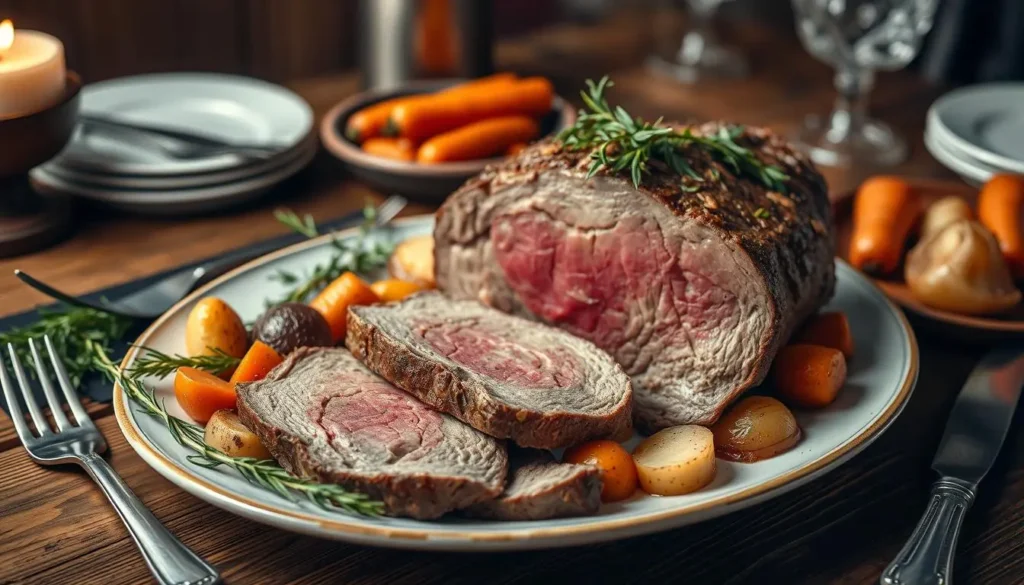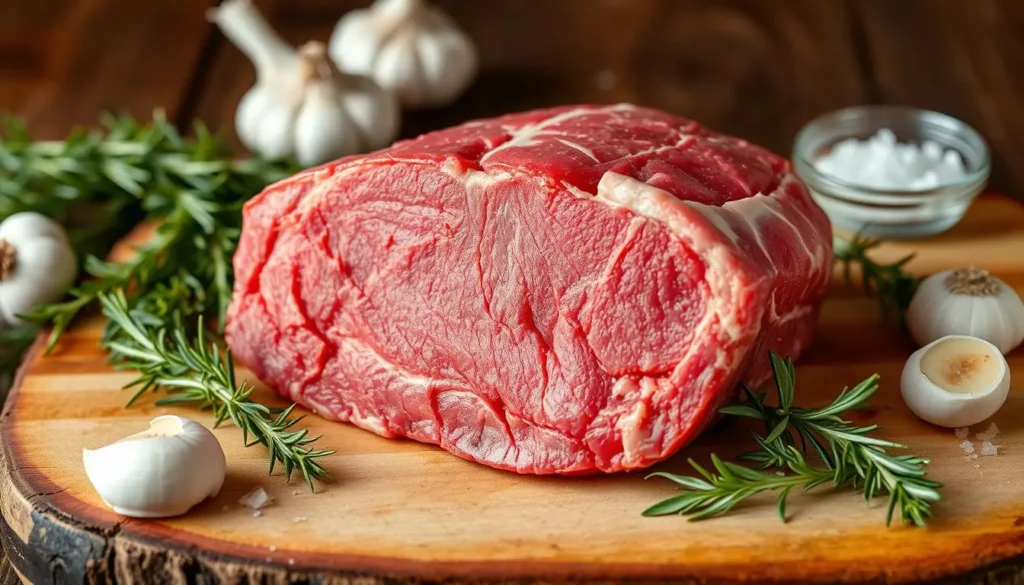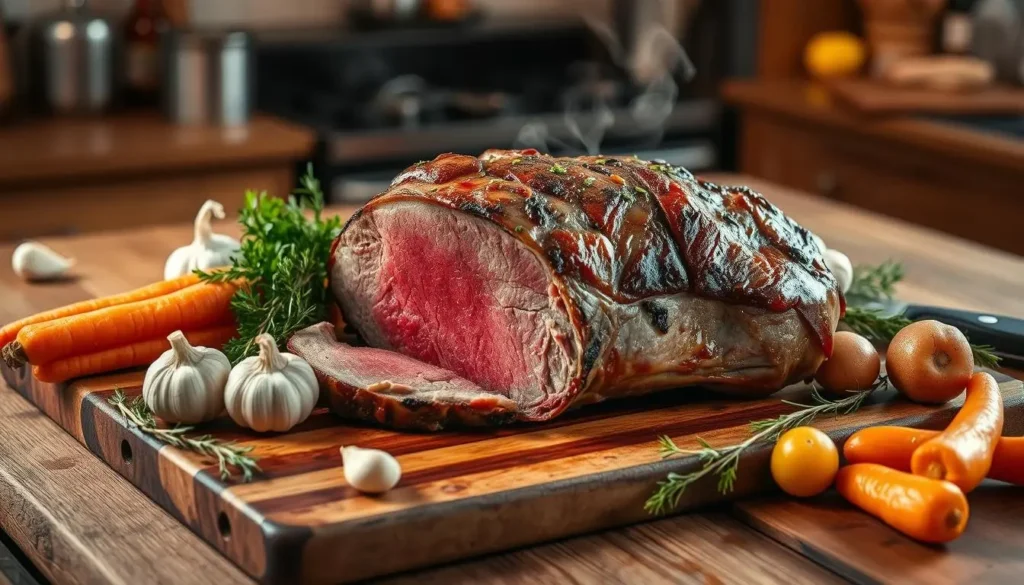What is a bottom round roast good for? This beef cut is often ignored, but it’s perfect for many dishes. If you’re searching for a bottom round roast recipe, you’ve come to the right spot. We’ll show you how versatile this roast can be and give you the tips to use it well.
Introduction to Bottom Round Roast
The bottom round roast is tasty and budget-friendly. With the right cooking, you can make a meal that wows everyone. This guide is for both experienced cooks and beginners, offering the secrets to a perfect roast.
Key Takeaways
- You can use a bottom round roast recipe to create a variety of delicious dishes
- The bottom round roast is a cut of beef that is both affordable and flavorful
- Cooking a bottom round roast requires the right techniques and methods
- A bottom round roast recipe can be used for special occasions or everyday meals
- With the right cooking methods, you can create a tender and juicy bottom round roast
- A bottom round roast is a great option for those looking for a budget-friendly meal
Understanding Bottom Round Roast: Basic Characteristics
Choosing the right cut of beef can be tricky. You might ask is top round or bottom round better for you. The bottom round roast comes from the cow’s rear, near the rump. It’s lean, making it great for slow cooking or braising.
The meat of the bottom round roast is firm and dense. This is ideal for specific cooking methods. Let’s look at its key features:

Location on the Cow
The bottom round roast is near the rump. This affects its tenderness and flavor. When comparing is top round or bottom round better, the top round is generally more tender.
Meat Texture and Marbling
The bottom round roast has a firm texture and less marbling. This makes it leaner, perfect for certain cooking methods. When deciding is top round or bottom round better, think about marbling and texture.
Nutritional Profile
The bottom round roast is lean, with lots of protein and low fat. It’s a favorite for those watching their diet but wanting a tasty beef dish.
In summary, knowing the basics of the bottom round roast helps decide is top round or bottom round better for you. Consider its location, texture, and nutrition. This way, you can enjoy a fulfilling and tasty meal.
Popular Cooking Methods for Bottom Round Roast
There are many ways to cook a bottom round roast for a tasty and tender dish. A good bottom round roast recipe is key to unlocking the meat’s full flavor. You can try roasting, slow cooking, or braising, each with its own benefits.
Roasting is excellent for a bottom round roast recipe that wants a crispy outside. It makes the meat tender inside. Slow cooking makes the roast fall-apart tender. Braising cooks the roast in liquid, like stock or wine, to add flavor and moisture.
- Roasting: perfect for a crispy outside and tender inside
- Slow cooking: great for a fall-apart tender roast
- Braising: ideal for adding flavor and moisture to the meat
A great bottom round roast recipe will show you how to prepare and cook the roast perfectly. Whether you roast, slow cook, or braise, the goal is to cook it right and let it rest before serving. With practice and patience, you’ll make a delicious bottom round roast that will wow your loved ones.
Best Temperature and Time Guidelines
When cooking a bottom round roast, knowing the right temperature and time is crucial. You might wonder, does a bottom round roast get more tender the longer you cook it? Yes, it does, but don’t overcook it. Overcooking can make the meat dry and tough.
A good starting point is to aim for an internal temperature of 130°F to 135°F for medium-rare. For medium, aim for 140°F to 145°F. The cooking time varies based on the roast’s size and thickness, and the cooking method. For instance, a 3-4 pound roast might take 2-3 hours in a slow cooker. A 2-3 pound roast could roast in the oven for 1-2 hours.
Cooking Duration Tips
- Use a meat thermometer to ensure the roast reaches a safe internal temperature.
- Let the roast rest for 10-15 minutes before slicing to allow the juices to redistribute and the meat to become more tender.
- Consider the size and thickness of the roast when determining the cooking time.
By following these guidelines and considering the factors that affect cooking time, you can achieve a deliciously tender bottom round roast. It’s sure to impress your family and friends.
What is a Bottom Round Roast Good For in Different Dishes
The bottom round roast is a versatile cut of beef. It’s great for making stews, soups, salads, and sandwiches. What is another name for bottom round roast? It’s also called the round roast or rump roast. It’s loved in many countries.
Here are some popular dishes you can make with it:
- Roast beef with mashed potatoes and gravy
- Beef stew with vegetables and crusty bread
- Salads with sliced roast beef and mixed greens
- Sandwiches with roast beef, cheese, and horseradish sauce
When cooking with the bottom round roast, you can use different methods.
Overall, the bottom round roast is a great choice for adding variety to your meals. Its rich flavor and tender texture make it a favorite at home.
Marinating Techniques for Enhanced Flavor
Marinating is key to making a delicious bottom round roast recipe. It adds flavor and tenderness to the meat. By choosing the right ingredients and marinating times, you can make a dish that tastes amazing.
To start, you need to know the basics of marinating. This involves soaking the meat in a mix of acid, oil, and spices. For a bottom round roast, you can use many marinade ingredients, such as:
- Acidic ingredients like vinegar or lemon juice
- Oils like olive or avocado oil
- Aromatics like garlic and herbs
- Spices like salt, pepper, and paprika
Best Marinade Ingredients
Finding the right balance of flavors is crucial for a great marinade. You can try different mixes to find the best one for your bottom round roast recipe.
Optimal Marinating Times
The marinating time depends on the roast’s size and thickness. A 2-3 pound roast usually needs 2-3 hours, while a 3-4 pound roast needs 4-6 hours. Here’s a table to guide you:
| Roast Size | Marinating Time |
|---|---|
| 2-3 pounds | 2-3 hours |
| 3-4 pounds | 4-6 hours |
Slow Cooking vs. Roasting Methods
Wondering does a bottom round roast get more tender the longer you cook it? Yes, it does, but the right method is key. Slow cooking and roasting are both popular. Slow cooking is great for those with busy lives, as it cooks the roast while you’re away. Roasting, on the other hand, is perfect for special events, as it creates a crispy, caramelized crust.

Some key differences between slow cooking and roasting include:
- Cooking time: Slow cooking takes longer than roasting, but it’s a great way to cook the roast while you’re away from home.
- Texture: Slow cooking can make the roast more tender, while roasting can produce a crispy crust on the outside.
- Flavor: Both methods can produce flavorful results, but roasting can add a richer, more caramelized flavor to the roast.
It’s also important to note that cooking the roast for a longer period can make it more tender, but overcooking can make the meat dry and tough. To achieve the perfect tenderness, it’s crucial to find the right balance between cooking time and temperature.
In conclusion, both slow cooking and roasting can produce delicious results. It’s essential to choose the right method based on your needs and preferences. By understanding the differences between these two methods and does a bottom round roast get more tender the longer you cook it, you can create a mouth-watering dish that’s sure to impress your family and friends.
Slicing and Serving Tips
Serving a bottom round roast means slicing it against the grain for tenderness. This is key when deciding is top round or bottom round better. Use a sharp knife for smooth, even cuts.
Proper Cutting Techniques
Proper cutting is crucial for your bottom round roast. Slice it into thin strips for easier serving. This way, you can see the differences between top and bottom round cuts and choose is top round or bottom round better.
Serving Suggestions
Pair your bottom round roast with sides like mashed potatoes, roasted veggies, and gravy. These enhance the roast’s flavor. You can also use it in sandwiches or salads for extra protein.
Leftover Storage
Proper storage keeps your bottom round roast fresh longer. Store it in the fridge for up to 3 days or freeze for 2 months. Reheat to 165°F (74°C) for safety.
Comparing Top Round and Bottom Round Cuts
Choosing between top round and bottom round cuts can be tricky. You might ask is top round or bottom round better for you. Both come from the cow’s rear, but they differ in texture and price.
Marbling is a key factor in both cuts. Top round is tender and has more marbling, enhancing flavor. Bottom round is leaner and firmer. This affects how you cook and what recipes you use.
Texture Differences
Top round is tender and flavorful, perfect for roasts and steaks. Bottom round, however, is better for slow cooking like braising or stewing. This method tenderizes the meat.
Price Comparison
Bottom round is generally cheaper, ideal for budget-conscious cooks. But, prices can vary by region and availability. Your choice depends on your taste and cooking style.
Understanding the texture and price differences helps you decide. Whether you like top round’s tenderness or bottom round’s value, both can be delicious. Choose wisely for your next meal.
Alternative Names and Cut Variations
Looking for a bottom round roast? You might find it called round roast or rump roast. What is another name for bottom round roast? It’s often labeled as round roast or rump roast in stores and butcher shops. This beef cut is loved in many places, like the U.S., Canada, and the U.K.
There are different cuts, like top round and inside round, from the same cow area as the bottom round. These cuts are great for various dishes. Knowing the differences helps you choose the right one for your meal. For instance, top round is softer, while inside round is leaner and has less fat.
Here are some key differences between the bottom round and its cut variations:
- Top round: more tender, with a finer texture
- Inside round: leaner, with less marbling
- Bottom round: flavorful, with a coarser texture
Learning about the different names and cuts of bottom round roast opens up new recipe possibilities. Whether you want a tender roast or a lean cut for stir-fries and sandwiches, there’s something for everyone.
| Cut | Tenderness | Marbling | Flavor |
|---|---|---|---|
| Top round | Tender | Less | Mild |
| Inside round | Lean | Less | Mild |
| Bottom round | Coarser | More | Rich |
Common Cooking Mistakes to Avoid
When cooking a bottom round roast, knowing common mistakes is key. Temperature control is crucial. A meat thermometer ensures the roast reaches the right internal temperature. This is important for both safety and tenderness.
It’s vital to watch the roast’s temperature to avoid overcooking or undercooking. Seasoning mistakes can also ruin the dish. To fix this, season well with salt, pepper, and herbs. Let it rest before slicing.
Temperature Control Errors
Use a meat thermometer to control temperature. The ideal internal temperature for a bottom round roast is between 135°F and 140°F for medium-rare. For medium, it’s 145°F to 150°F.
Seasoning Missteps
Seasoning mistakes can be prevented by using plenty of salt, pepper, and herbs. Garlic, thyme, and rosemary are great choices. Letting the roast rest before slicing helps keep it tender.
By avoiding these mistakes, you can make a delicious bottom round roast. It will impress your family and friends.
| Internal Temperature | Level of Doneness |
|---|---|
| 135°F – 140°F | Medium-rare |
| 145°F – 150°F | Medium |
| 155°F – 160°F | Medium-well |
| 165°F – 170°F | Well-done |
Budget-Friendly Meal Planning with Bottom Round
A bottom round roast recipe is perfect for saving money. This beef cut is cheaper than others, great for families and singles. Cooking it in bulk lets you use leftovers in many dishes all week.
Here are some ways to use leftover bottom round roast:
- Adding it to soups or stews for a protein boost
- Using it in salads or sandwiches for a quick and easy lunch
- Shredding it and using it in tacos or other Mexican-inspired dishes
Using a bottom round roast recipe is smart for meal planning. It’s affordable and versatile. Cooking in bulk and reusing leftovers saves time and money, while still offering tasty meals.

Conclusion: Making the Most of Your Bottom Round Roast
The bottom round roast is a tasty and affordable choice for meals. It becomes tender and flavorful with the right cooking. This makes it perfect for many dishes.
It works well with slow-cooking or roasting, fitting your cooking style. Try different marinades and seasonings to bring out the meat’s natural taste. This way, every meal will be a hit.
To get the best out of your roast, focus on temperature, cooking time, and slicing. Follow these tips to cook it just right. You’ll enjoy it in stews, sandwiches, and more.
When planning meals or shopping for meat, think about the bottom round roast. It’s a cost-effective choice that can impress everyone. With this guide, you’re ready to make delicious meals with this versatile beef cut.
FAQ
What is a Bottom Round Roast Good For?
The bottom round roast is great for many dishes. You can use it in stews, soups, salads, and sandwiches. It’s also perfect for roast beef, served with mashed potatoes, roasted veggies, and gravy.
How Does a Bottom Round Roast Compare to a Top Round Roast?
The top round is more tender and has more marbling than the bottom round. The bottom round is leaner and firmer. The top round is also pricier than the bottom round.
Does a Bottom Round Roast Get More Tender the Longer You Cook It?
Yes, longer cooking makes the bottom round roast tender. But, don’t overcook it. The ideal temperature is between 130°F and 135°F for medium-rare, and 140°F to 145°F for medium.
What is Another Name for a Bottom Round Roast?
It’s also called the “round roast” or “rump roast.” It’s loved in the U.S., Canada, and the U.K.
What are the Best Cooking Methods for a Bottom Round Roast?
Roasting, slow cooking, and braising are top methods. Roasting browns the outside while keeping the inside tender. Slow cooking makes it fall-apart. Braising adds flavor and moisture.
How Do You Properly Slice and Serve a Bottom Round Roast?
Slice it against the grain with a sharp knife to avoid drying. Serve with mashed potatoes, roasted veggies, and gravy. Store leftovers in the fridge for up to 3 days or freeze for 2 months.
What are Some Common Cooking Mistakes to Avoid with a Bottom Round Roast?
Avoid temperature control errors and seasoning mistakes. Use a meat thermometer for the right temperature. Season well with salt, pepper, and herbs.
How Can You Use a Bottom Round Roast for Budget-Friendly Meal Planning?
It’s a budget-friendly choice, often cheaper than other beef cuts. Use it in stews, soups, salads, and sandwiches. Cooking it in bulk and using leftovers is a smart way to save money.

